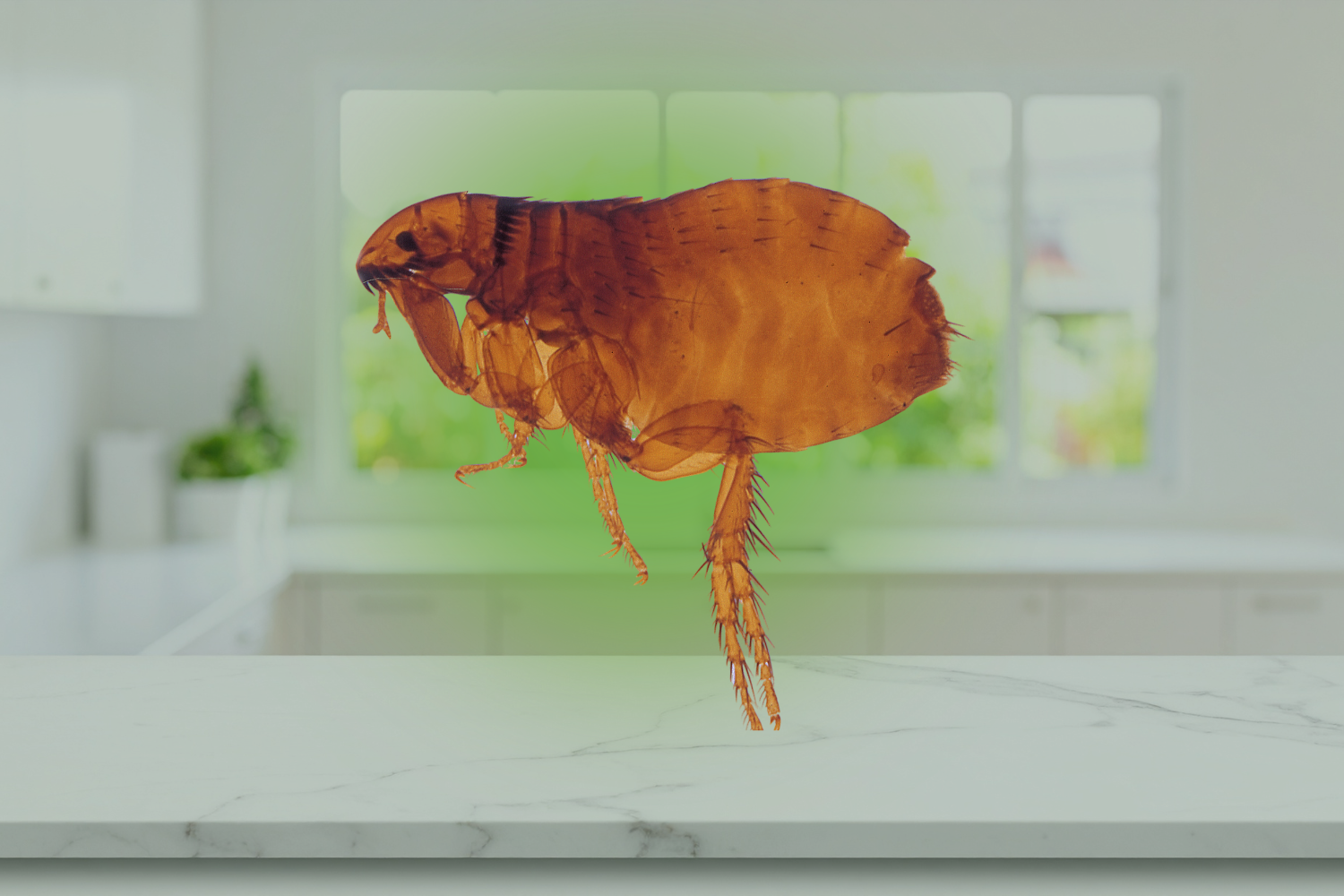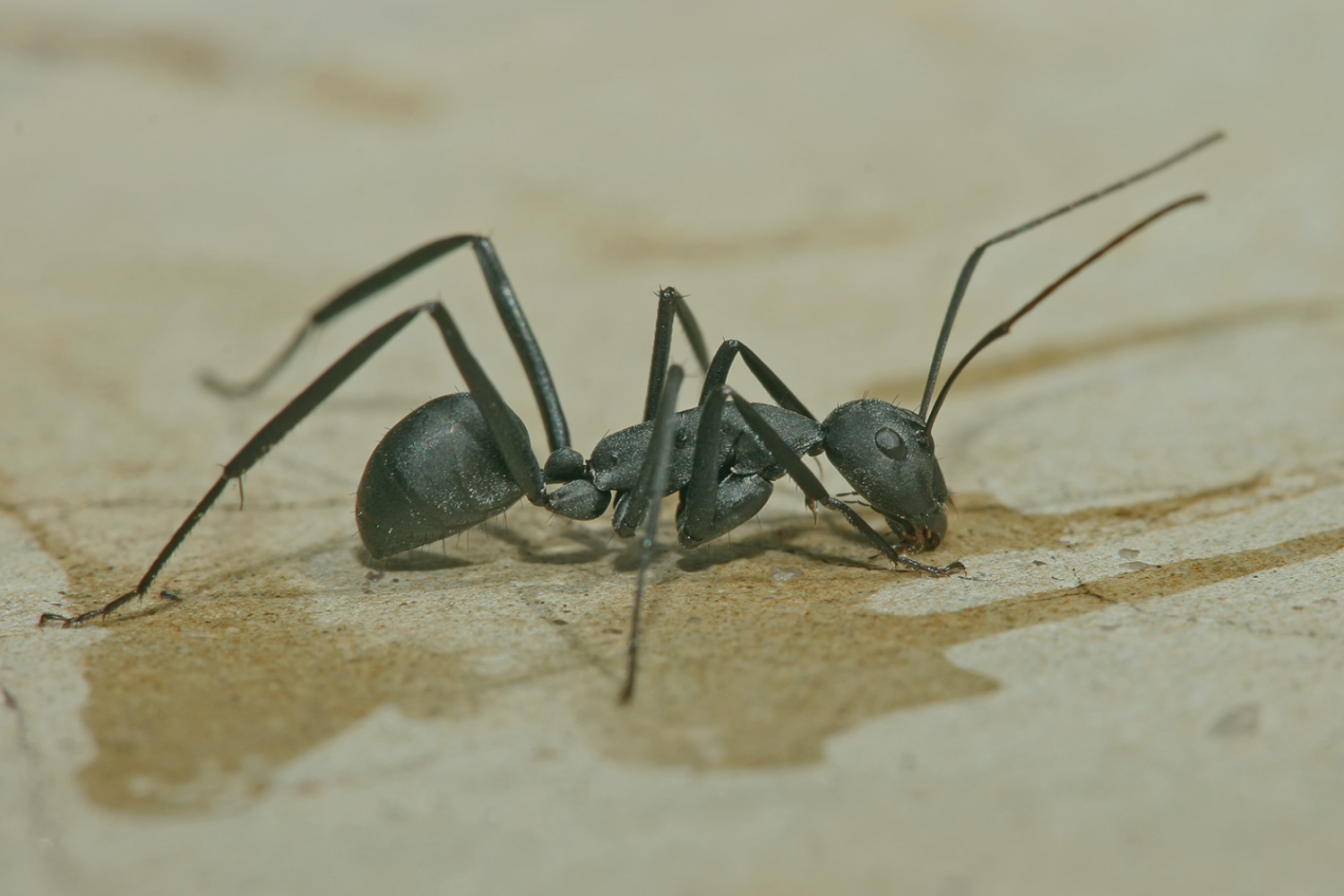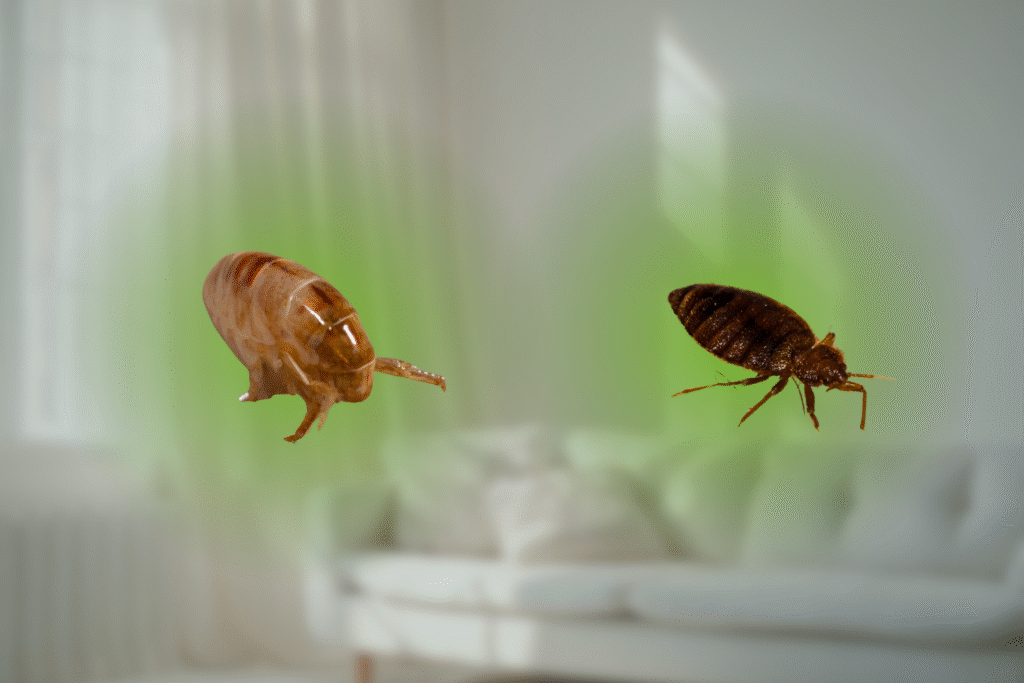
Waking up with itchy bites and no idea what caused them can be frustrating, especially when you’re trying to figure out whether you’re dealing with fleas vs bed bugs, two of the most common pests homeowners in the Pacific Northwest face.
Both pests can cause discomfort, sleepless nights, and even allergic reactions. However, understanding which one you are dealing with is essential because the treatments for each are completely different.
In this guide, you will learn how to tell the difference between fleas vs bed bugs, what their bites look like, where they hide, and how to get rid of them for good.
You will also find practical tips from Bigfoot Pest Management, your trusted local pest control experts serving homes and families across Washington state.
Why It’s Important to Know the Difference
At first glance, flea and bed bug infestations can look similar. Both leave behind red, itchy bites, and both are small enough to hide easily. Yet, identifying the wrong pest can lead to wasted time and money on treatments that do not work.
Fleas usually come from pets or wildlife that carry them inside. They can jump high and spread quickly through carpets and furniture.
Bed bugs, on the other hand, are expert hitchhikers that attach to luggage, clothing, or used furniture. They crawl instead of jumping, and hide in cracks and crevices near sleeping areas.
If you mistake fleas for bed bugs or vice versa, you might use the wrong treatment. For example, using flea shampoo or sprays will not kill bed bugs, and washing bedding alone will not stop a flea problem if pets are untreated. Knowing the difference between fleas vs bed bugs helps you act fast and effectively.
When in doubt, schedule a professional inspection with Bigfoot Pest Management. Our licensed technicians can confirm what pest is inside your home and recommend a targeted plan to eliminate it.
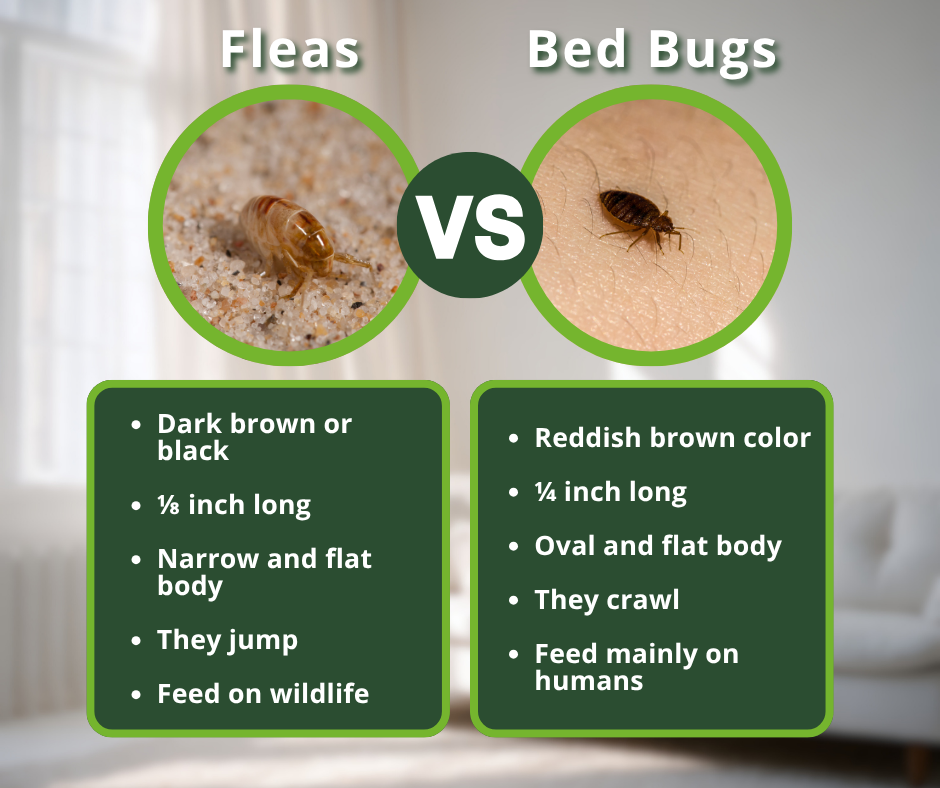
Fleas vs Bed Bugs: What’s the Difference?
Fleas and bed bugs might both be small, but their appearance and behavior are easy to tell apart once you know what to look for.
Fleas:
- Dark brown or black in color
- About 1/8 inch long
- Narrow and flat body shape
- Jump long distances using strong back legs
- Prefer to feed on pets and wildlife
- Active throughout the day and night
Bed Bugs:
- Reddish-brown in color
- About 1/4 inch long
- Oval and flat body shape
- Crawl instead of jumping
- Feed mainly on humans
- Most active at night
Fleas thrive in homes with pets, especially dogs and cats, but can also live in places where wild animals have been. Bed bugs crawl slowly and feed mostly at night while people sleep, hiding in warm, dark places near beds or furniture.
How to Identify Flea Bites vs Bed Bug Bites
When you notice red, itchy bumps, it is normal to wonder which pest bit you. Although both pests feed on blood, their bite patterns and locations can help you identify them.
Flea Bites
- Appear as small red bumps, often with a lighter halo around them
- Commonly found on feet, ankles, and lower legs
- Very itchy and sometimes leads to small scabs
- Often appear after pets start scratching more than usual
Flea bites usually happen when you are sitting or walking through areas where fleas live, such as carpets or furniture. Pets often show signs first, so always check them if you suspect fleas.
Bed Bug Bites
- Often appear in small clusters or straight lines
- Common on arms, back, neck, and face
- Typically show up overnight
- May swell slightly and feel itchy in the morning
Bed bug bites often occur on areas exposed while you sleep. Unlike fleas, bed bugs feed for several minutes before retreating to their hiding spots.
Pro Tip: Some people do not react to bed bug bites at all, while others develop severe allergic reactions. Because reactions vary, physical inspection is always the best way to confirm an infestation.
Where Fleas and Bed Bugs Hide in Your Home
Finding where these pests live is key to stopping them. Both can hide well, but they have different habits and environmental needs that explain why they choose certain spots.
Flea Hiding Spots
- Pet bedding, carpets, and rugs
- Furniture cushions and throw blankets
- Cracks along baseboards or wood flooring
- Areas where pets rest or sleep
Fleas prefer warm, shaded areas with fabric or carpet fibers that protect them from light and movement. Their flat bodies allow them to slip between fibers, and they lay eggs deep inside soft materials, where vacuuming might not reach.
Fleas also stay close to where pets sleep because they rely on a consistent host for food. When pets rest, fleas jump on for a quick meal, then return to the environment to lay eggs.
Homes with pets or nearby wildlife, such as raccoons or squirrels, are especially attractive to fleas because these animals act as carriers. Even if your pet is treated, untreated animals outside can reintroduce fleas to your home through open doors, yards, or crawl spaces.
Fleas also like humid, warm environments, which is why they thrive in places like the Pacific Northwest, where the air holds more moisture. If you notice more activity during warmer months, it’s not your imagination; that’s their ideal breeding season.
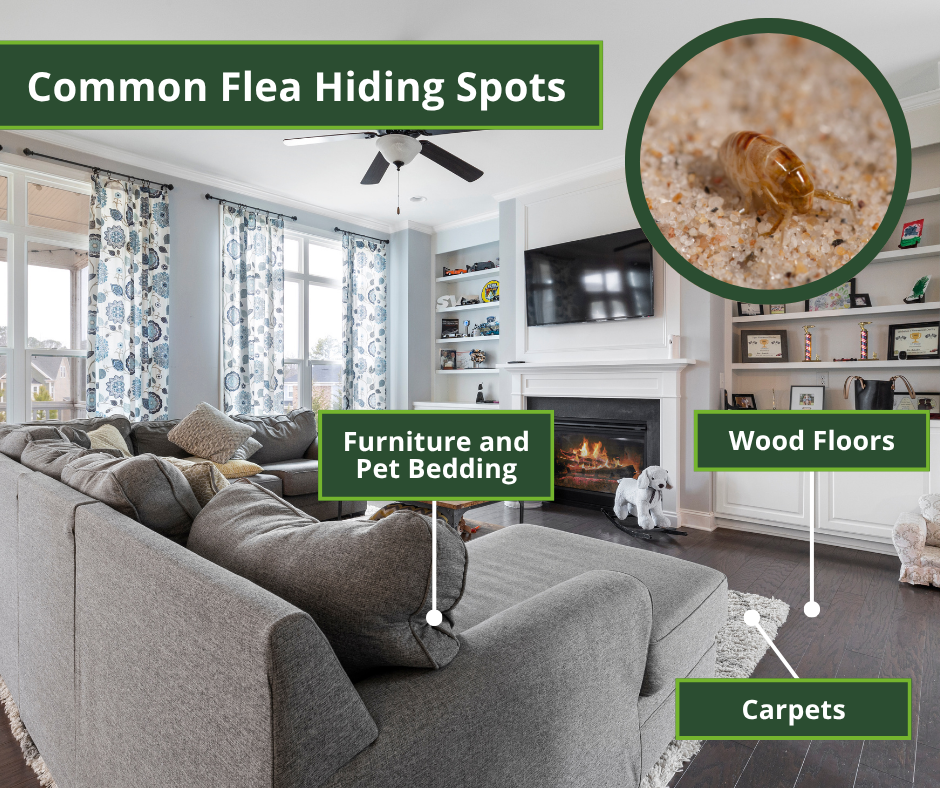
Bed Bug Hiding Spots
- Mattress seams, box springs, and headboards
- Behind wallpaper, picture frames, or wall outlets
- Upholstered furniture and curtains
- Luggage, clothing, or secondhand furniture
Bed bugs hide close to their food source, which is humans. They are nocturnal and feed at night, so they prefer dark, undisturbed areas near beds or couches where people rest for long periods.
Cracks in wood furniture, seams in mattresses, or folds in curtains provide the perfect shelter between feedings.
They also hide behind outlets, baseboards, and wall hangings because these areas are tight, dark, and rarely disturbed. Bed bugs only need a space the width of a credit card to squeeze in and stay protected.
Used or secondhand furniture is another favorite hiding spot because it gives them a free ride into new homes. They can remain dormant for months, waiting until they sense heat and carbon dioxide from a potential host.
Once they find a food source, they reproduce quickly, spreading through nearby rooms or apartments.
Understanding these hiding preferences helps homeowners target cleaning and inspection efforts more effectively. When you know where these pests live, you can better detect the early signs and call Bigfoot Pest Management before the infestation grows out of control.

Signs You Might Have an Infestation
The earlier you spot an infestation, the easier it is to handle. Here are the most common signs to watch for.
Signs of a Flea Infestation
- Pets constantly scratching or biting their skin
- Tiny black specks (flea dirt) on bedding or furniture
- Small jumping insects are visible on carpets or curtains
- Bites that appear soon after sitting on fabric or carpet
Signs of a Bed Bug Infestation
- Rust-colored stains or dark spots on sheets or mattresses
- Tiny white eggs or molted skins near sleeping areas
- Musty or sweet odor around your bed
- Seeing live bugs at night around headboards or walls
Quick Tip: If you notice signs but are unsure which pest you are dealing with, Bigfoot Pest Management can perform an inspection using professional tools that detect pests even when they are hiding deep inside furniture or walls.
How to Get Rid of Fleas and Bed Bugs for Good
Getting rid of fleas or bed bugs takes persistence and proper treatment. Here’s what you can do for each pest.
How to Get Rid of Fleas
- Treat your pets: Consult your veterinarian for approved flea medication.
- Vacuum daily: Focus on carpets, rugs, and under furniture. Empty the vacuum outside each time.
- Wash all fabrics: Use hot water and high heat drying to kill all life stages.
- Call a pest professional: Bigfoot Pest Management uses specialized treatments that reach deep into carpets and cracks to stop infestations completely.
How to Get Rid of Bed Bugs
- Inspect every surface: Look along mattress seams, headboards, and wall joints.
- Wash and heat-dry bedding: High temperatures kill bed bugs and eggs.
- Use a mattress cover: Traps remaining bugs and prevents new ones from hiding.
- Professional heat treatment: The most effective and chemical-free method to eliminate all stages of bed bugs in one visit.
Important: DIY treatments may kill a few bugs but rarely address the full infestation. Professional pest control ensures every bug and egg is destroyed, preventing re-infestation.
Professional Pest Control vs DIY Methods
DIY sprays and online tips often promise quick fixes but rarely work long term. Fleas and bed bugs are resilient pests that require expert equipment and products.
DIY efforts may fail because:
- Flea eggs can survive for weeks and hatch later.
- Bed bugs hide in areas that home sprays cannot reach.
- Store-bought products are weaker than professional-grade solutions.
Professional pest control offers:
- Proven treatments designed for your specific pest problem.
- Targeted heat and chemical options that eliminate bugs at all life stages.
- Follow-up inspections to ensure your home stays pest-free.
Bigfoot Pest Management’s team uses science-backed strategies to eliminate pests safely and effectively, helping local families maintain healthy, comfortable homes.
How to Prevent Fleas and Bed Bugs from Coming Back
The best pest control is prevention. Here are simple ways to reduce the chance of re-infestation.
Flea Prevention Tips
- Apply vet-approved flea treatments to pets monthly.
- Wash and vacuum pet bedding regularly.
- Groom pets often to check for signs of fleas.
- Keep lawns trimmed and remove debris that attracts wildlife.
Bed Bug Prevention Tips
- Inspect luggage, clothing, and furniture after travel.
- Avoid bringing used mattresses or couches into your home.
- Use light-colored bedding to spot pests faster.
- Schedule annual pest inspections to catch early signs.
By maintaining these habits, you can drastically lower your risk of another infestation.
Related Questions
Can fleas and bed bugs live on humans?
Fleas can bite humans but prefer animal hosts. Bed bugs feed on humans but live in furniture, not on skin.
Do I have to throw away my mattress if I have bed bugs?
No. Professional heat treatments kill all bed bugs and eggs, so your mattress can usually be saved.
How long do fleas and bed bugs live without a host?
Fleas can survive up to two weeks without a host, while bed bugs can live for months in hiding. Therefore, they are hard to get rid of.
What’s the fastest way to get rid of fleas in my house?
Treat your pets and hire a pest control expert to apply a full home treatment.
Can pets bring bed bugs inside?
While bed bugs do not live on animals like squirrels, they can travel on pet bedding or carriers.
When to Call a Professional
If you still see bites after cleaning, washing, or spraying, it’s time to bring in an expert. Fleas and bed bugs multiply quickly, and missing even a few eggs can restart an infestation.
Bigfoot Pest Management provides thorough inspections and customized treatment plans for local homeowners. Our trained technicians identify exactly which pest is in your home and use proven methods to remove them. We also offer guidance to help prevent them from returning.
Whether you are dealing with a small issue or a widespread infestation, our team will restore your home’s comfort quickly and safely.
Conclusion
Fleas vs bed bugs might seem similar, but their behavior and treatment are completely different. By learning how to spot each pest, you can act quickly and avoid making the problem worse.
At Bigfoot Pest Management, we take pride in helping homeowners throughout the Pacific Northwest identify and eliminate pests effectively. Our local team understands the region’s unique pest challenges and provides friendly, professional service you can count on.
If you suspect fleas or bed bugs in your home, do not wait. Schedule your professional inspection today and take back your peace of mind.
What Does a Home Infestation of Fleas Look Like?
An infestation of fleas looks like repeated bites on people or pets, constant scratching, and small dark insects jumping from carpets, furniture, or pet bedding.…
Read MoreWhat Do Carpenter Ants Look Like in Washington Homes?
When homeowners ask what do carpenter ants look like in Washington homes, the answer is simple. Carpenter ants are large black or dark red ants…
Read More



